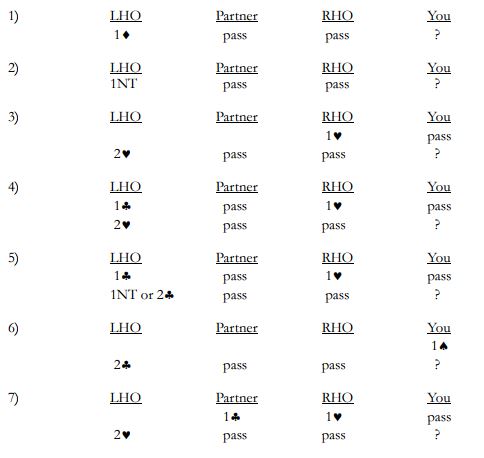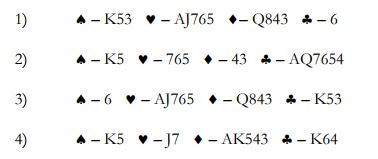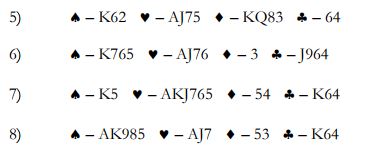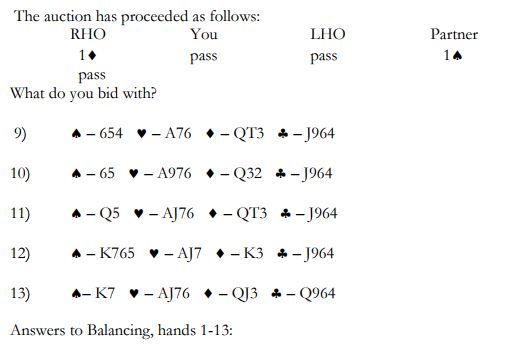 These are among the most common:
These are among the most common:
1) Balancing after 1 of a suit-pass-pass
2) Balancing after 1NT-pass-pass
3) and 4) Balancing after both opponents have bid and found a fit.
5) Balancing after both opponents have bid and not found a fit.
6) and 7) Reopening to “protect” partner’s hand
When RHO opens one of a suit, bidding entails some risk – the opponents’ strength is as yet unlimited; partner could be broke. When the opponents pass at a low level, however, they have announced that they do not have the values for game. Partner can now be credited with a certain amount of strength. If the opponents have found a fit and stopped at a low level, the situation is even better; it improves the chances that our side has a fit as well. So in balancing position, we should be a little more aggressive. On fitting auctions we should be more aggressive still.
The reasons for and risks of balancing actions are somewhat different from actions in direct seat. We still would like to suggest a possible contract to partner, or get partner off to the best lead. But we aren’t interfering with the opponent’s auction; it has already died. On many balancing auctions it is much less likely that we will get doubled and go for too big a set. However, reopening the auction can, in some cases, allow the opponents back in to find a better fit. The main reason to balance is that it may be our hand; we may have enough values to outbid the opponents; we may even have game. To understand when to balance and when not to balance, we must try to get a general idea of the points and distribution of the other hands – especially partner’s.
When the auction has proceeded 1 of a suit, pass, pass –
We know that opener has about 12-20 points, and responder 0-5. On average, the opponents will have anywhere from 16-22 points. They could have a little more, they could have a little less. (If the opponents are very aggressive bidders, they won’t have much more and could have a bit less). It is a good rule of thumb to assume that they have about 16-22, and we have about 18-24. If we have 10 points, then partner has about 8-14. When balancing after 1 of a suit, pass, pass – don’t count on partner for more than about 15 pts or so. With 17 or more points, avoid the “trap pass”. The person who gets “trapped” is often partner.
We also need to consider suit distribution. If we are short in an unbid suit, then either partner has length in that suit, or the opponents’ have a fit in that suit. Yet if partner is marked with values he might have overcalled with a long suit (especially if he could have done so at the 1-level); if he doesn’t have length, then the opponent’s may have a better fit.
When the auction has proceeded 1NT, pass, pass –
Now there is no such assurance that partner has values. Opener has a balanced 15-17. Responder has anywhere from 0-8, and is likely balanced, or he would have bid something. When the auction has proceeded 1 of a suit, pass, raise to 2, pass, pass – Opener has about 12-15 points, and responder about 6-9. On average, each side will have about 18-22 points. The opponents have a fit, so it is likely that we also have a fit somewhere.
Balancing after 1 of a suit, pass, pass:
What do various actions mean in balancing position? Constructive actions – simple overcalls, doubles and 1NT overcalls retain their meanings, though these actions can be made with less strength than is required in direct seat. There is little logic to preemptive bids in balancing seat – we can end the auction by passing. So jump overcalls should be natural and fairly strong. A jump to 2NT is usually played as a strong balanced hand, though a few players play it as a good hand with the 2 lower unbid suits. A cue-bid is played many ways – as a good Michaels hand, or one of several types of powerful 2- or 3-suited hands.
Bids in balancing seat can be made about 3 points lighter than in direct seat: A simple overcall at the one level should show about 7-13 points but could be made with as few as 6 or 7 points and a good suit. A simple overcall at the 2 level should show about 9-14 points. With maximum values and a good suit, the hand qualifies for a jump overcall. A takeout double has no upper limit, but can be made with as few as 8-9 points with very good shape. A 1NT overcall should show about 12-15 points, and a reasonably balanced hand with opener’s suit stopped. With 16-18, double first and then bid NT as cheaply as possible. With 19-21, jump to 2NT immediately. A single jump overcall shows a hand with a reasonable suit, but a little too good for a simple overcall.
A single jump overcall to the 2 level should show a fair 6-card suit and about 12-16 points – if on the low end, a very good suit is needed. A single jump overcall to the 3 level should show about 14-17 points and a good 6-card suit. With enough points, but without a very good suit, double and then bid the suit. Higher jump overcalls should also be strong. There is little agreement even among experts as to what this bid should mean. A double jump to 3 of a major should show about 7 playing tricks and a very good suit. A jump to 4 of a suit should show about 8 playing tricks. This suit will be trump.
Try to balance whenever you have a good action. With a good suit, balance in that suit. Make a simple overcall, jump overcall, or double and bid the suit – whichever is appropriate. With values and support for the other suits, double. With values and a balanced hand, including stoppers in opener’s suit, balance in NT. Bid 1NT, double and bid NT, jump to 2NT – depending on high-card strength.
On marginal hands, when deciding whether or not to balance when a one-bid is passed around to you, here are some guidelines to keep in mind: Avoid balancing with length in the opponents’ suit. When you have length in the opponents’ suit, partner is marked with shortness. Yet partner would strain to act in direct seat with shortness in the opponents’ suit, either with an overcall or a double. The fact that he did not do so suggests he does not have values.
Avoid balancing with shortness in an unbid suit, especially an unbid major. Either partner has this suit, or the opponents have a fit in this suit. Since partner did not overcall in this suit, he either does not have this suit (in which case the opponents have a better fit available, and might find it if you give them another chance) or he does have this suit (in which case he does not have the values for an overcall). Avoid balancing with very weak hands, even with a long suit or with great distribution. Partner should strain to do something with a good hand. He should not have more than 15-16 points. The fact that he passed suggests he does not have that many points. The hand belongs to the opponents. The may find a better contract if you give them a chance.
Responses to Balancing Bids
Since actions in balancing position show about 3 points less than those in direct seat, responses must show about 3 points more.
After partner balances with a suit:
Partner typically has less than opening-bid strength, so you are free to pass with a weak hand and no fit. A raise of partner’s suit shows about 8-11 points and support. (Over an intervening bid a raise may be made with a slightly weaker hand – opener bids again, stretch to raise if you have a fit).
A jump raise of partner’s suit shows about 11-13 points and good support.
No-trump bids are natural, showing stoppers in the opponent’s suit and no fit for partner’s suit if it a major. (It is preferable to bid NT than to jump in partner’s minor). It is important to remember that partner could have as few a 7-8 points. Over a 1 level balancing overcall, a bid of 1NT shows about 9-12 points, a jump to 2NT shows about 13-14. Over a 2-level balancing overcall, a bid of 2NT shows about 12-14. In either case, a jump to 3NT should show about 15-16 points with some kind of help in partner’s suit.
A new suit bid shows a 5-card or longer suit and a good hand, usually 11 or more points. Over a major-suit overcall, a bid in a new suit should deny support for partner’s suit. A cuebid (a bid of the opponent’s suit) should show a good hand. It should suggest that game be reached unless balancer and responder are both minimum.
After partner balances with a double:
Partner may be extremely light. We need about 3 more points to jump or bid NT than we would need in direct seat. A jump in a suit should show about 11-14 points. A 1NT bid should show 11-13 points and the opponent’s suit stopped. A jump to 2NT should show about 14-15.
After partner balances with 1NT:
Partner has a fairly balanced hand with about 12-15 points. There are several ways to play responses. You can play “all systems on” – Stayman, Transfers, etc.
The auction goes 1

 Answers to Balancing, hands 1-13:
1. Bid 1
Answers to Balancing, hands 1-13:
1. Bid 1
























